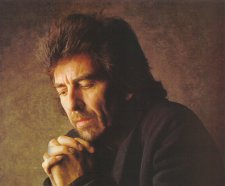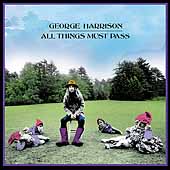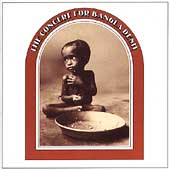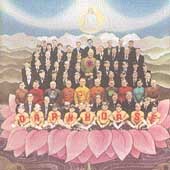All Things Must Pass: Remembering George Harrison
| All Things Must Pass: Remembering George Harrison |
| Commentary |
| Greg Weaver |
| 30 November 2001 |

In Memory of George Harrison
(25 March 1943 – 29 November 2001)
Very nearly the first words I heard as my radio alarm gently nudged me toward consciousness last Friday morning were the words, “George Harrison, former Beatle, is dead of cancer at age 58.” I found my still sleepy train of thought reeling back to my childhood in Arizona in early spring 1964. While playing with a friend, a song had come on the family transistor radio; a memorable little ditty called “I Want to Hold Your Hand.” The vision seemed so clear.
I spent this past weekend listening to all my Beatles albums and his solo work, trying to put his work in perspective. I can’t imagine there is a single reader anywhere in the world who won’t recognize his name. He was one fourth of a storm known as the Beatles that had caught the public’s attention in 1963 and lasted nearly seven years through the spring of 1970. As an aside, I did all this reminiscing with the new Music Hall MMF-7 and it is just a superbly musical turntable (full review in the works).
Born to Harold and Louise Harrison on 25 February 1943 (making him the youngest Beatle), he grew up in a fairly typical working class family with two brothers and one sister in the bombed out district of Liverpool, London. His father worked in the international shipping yards of Liverpool, a job that gave him easy access to new records from the United States. One of George’s early favorites was Jimmy Rogers, and during his school years, he listened to guitarists like Carl Perkins, Duane Eddy and Chet Atkins. He soon gravitated to the burgeoning Rock And Roll movement and players like Buddy Holly and Eddie Cochran. His fascination with these idols soon led him to pick up a guitar when he was 13 years old. By age 15, his schoolmate Paul McCartney had introduced him to an older Art College student and fellow musician, John Lennon. He soon found himself sitting in when one of the members of The Quarry Men didn’t show, and by 16 had become a permanent member of the group. He is actually responsible for teaching John to play guitar.
By 1960, another of John’s Art College friends, Stuart Sutcliff, joined the Quarry Men on bass, and Pete Best became their full time drummer by that summer. The group played clubs in London, now changing their name to The Silver Beatles. They eventually got a series of gigs in the red-light district of Hamburg Germany, where they finally dropped the “Silver” from the name and became just The Beatles. They continued to play clubs in London and Hamburg through 1961, but in early 1962, Sutcliff died of a brain hemorrhage and by that fall, Best was voted out of the band, for reasons still not entirely clear. When Ringo Starr (Richard Starkey) joined the Beatles in August of 1962, the Fab Four were set.
Brian Epstein, a London record shop owner, took time over lunch to go hear this local group and was so impressed that he asked the band to let him be their manager. Once producer George Martin got involved, the rest is history.
Their first album, released in the UK in 1963 was Please Please Me, followed shortly by Introducing the Beatles. With the Beatles was their third record of 1963, and really set the stage for their US invasion. 1964 saw the release of Meet the Beatles, which lets us hear the first solo Harrison composition “Don’t Bother Me,” effectively speaking to his basic desire to stay out of the spotlight. The Beatles 2nd Album (who taught these guys to count?) came out later that year, and with Beatlemania now in full force, the group made what would come to be recognized as the first music video, A Hard Day’s Night. It was with the title song on that album that George introduced fans to brand new type of guitar, the 12-string Richenbacker. George met Patty Boyd on the set of the film, and they eventually married in January 1966.
George tried to contribute songs to the early Beatles albums, but was dominated by the song writing dynamic of Lennon-McCartney. He was consistently ignored and relegated to playing “these notes, this way on this song” by both Lennon and McCartney, but given his gentle nature and quiet demeanor, he said very little about it. In those years, George was seen as “the quiet Beatle”, since he didn’t smile that much and truly didn’t relish the limelight. That year saw two more albums, Something New and Beatles For Sale.
With their three works in 1965, George began to be successful at getting some of his songs included on their albums. That year also brought a self-lampooning of Beatlemania with Help. One scene in Help shows George accepting a book on eastern religion from a man riding down the beach on horseback. This was to prove to be the beginning of a new George Harrison and a lifelong devotion to spirituality and the pursuit of eastern religion.
This influence first really shows itself on the Rubber Soul album with George introducing the sitar to pop fans on the song “Norwegian Wood.” By now, George had begun to go to John with his songs before studio sessions in an attempt to lobby for his work to appear on Beatle’s albums. By Revolver, he was beginning to come into his own, leading with his anthem “Taxman,” an open complaint about the tax burden the Beatles were feeling in the UK, and two others, “I Want to Tell You,” and “Love You To.” It was also about this time that he started serious study in Transcendental Meditation with Maharishi Mahesh Yogi and was introduced to Ravi Shankar at a dinner party in London.
By the summer of love (1967), LSD had come to be seen by many as a means toward increased awareness and heightened spirituality. The Beatles were no exception and this experimentation led George even closer to the religions of the east. This experimentation by the band is apparent in 1967’s Sgt. Peppers Lonely Hearts Club Band, and carried over on Magical Mystery Tour as well.
While Magical Mystery Tour was climbing the charts, George released the first solo Beatle album, and the first production on the Apple label, Wonderwall Music. Though George neither sang nor played on this album, it is significant as it marked the first individual project by any member of the Beatles.
Upon completion of Sgt. Pepper’s, the whole band took a long trip to India. This trip, and its impact on the entire group, affected 1968’s The Beatles, better known as the White Album. By this time, George’s influence and talent as a songwriter had become more dominant than ever, giving us one of his most hauntingly beautiful songs, and an unquestioned Beatle classic, “While My Guitar Gently Weeps.”
His second solo work. Electronic Sound came in 1969 and consisted of two tone poems of electronic music realized on a moog. His mentor for this experimental work was California electronic composer Bernie Krause, and though it didn’t fare well, it was one of the most radical directions he had taken musically to date.
Though bickering between the members was at an all time high, and maybe perhaps even because of it, George began to take on a stronger role as a songwriting. With the Abby Road record in 1969, he clearly shines through with such standards as “Here Comes The Sun” and “Something.” But by spring of 1970, the magic that had been the Beatles was finally pronounced dead. Though John had drifted away from the group with new wife Yoko Ono, fueling speculation that the end was apparent, it was Paul’s formal announced that he was leaving the Beatles that spring that finally quelled the most significant pop and rock group of its era.
Suddenly, George Harrison found himself free. Free of the egos, restraint and repression of the Lennon-McCartney stranglehold. In 1970, George Harrison gave us what most feel to be his seminal work, All Things Must Pass.  Here we get such classics as “My Sweet Lord”, “Isn’t it a Pity” and “What is Life.” For the record, there was a successful lawsuit filed by the publisher of the 1962 Chiffons hit, “He’s So Fine,” with the court finally ruling that the remarkably similar chord progression was the result of unconscious plagiarism. This judgement really affected George, and those close to him at the time say that it was a devastating blow his self-confidence.
Here we get such classics as “My Sweet Lord”, “Isn’t it a Pity” and “What is Life.” For the record, there was a successful lawsuit filed by the publisher of the 1962 Chiffons hit, “He’s So Fine,” with the court finally ruling that the remarkably similar chord progression was the result of unconscious plagiarism. This judgement really affected George, and those close to him at the time say that it was a devastating blow his self-confidence.
1971 brought us The Concert for Bangladesh, a two evening event held in New York’s Madison Square Garden that was a collaboration  with long-time friends Eric Clapton, Leon Russell, Ravi Shankar, Ringo Starr and Bob Dylan in an effort to raise money for that famine-ravaged nation. I saw this concert film when it was screened at the all night party held by my High School Senior graduating class, and it literally amounts to the first rock benefit in history.
with long-time friends Eric Clapton, Leon Russell, Ravi Shankar, Ringo Starr and Bob Dylan in an effort to raise money for that famine-ravaged nation. I saw this concert film when it was screened at the all night party held by my High School Senior graduating class, and it literally amounts to the first rock benefit in history.
 Living In the Material World, released in 1973, is a close contender for the accolade of his best work. Buoyant and uplifting at times, humorously ironic at others, here George seems remarkably confident in both his abilities as a singer and songwriter for the first time, and it has been a personal favorite of this listener since first play.
Living In the Material World, released in 1973, is a close contender for the accolade of his best work. Buoyant and uplifting at times, humorously ironic at others, here George seems remarkably confident in both his abilities as a singer and songwriter for the first time, and it has been a personal favorite of this listener since first play.
Several more albums followed in annual sequence, Dark Horse in 1974, Extra Texture in 1975 and 33&1/3 in 1977 on the heels of the creation of his own label, Dark Horse. His intense devotion to his  personal spirituality had taken its toll on his marriage. He and Patty divorced, and amid much controversy, she remarried Eric Clapton the same year. George attended the wedding, but there were rumors that the two had been in love for some time. The Derek and the Domino’s album Layla & Other Assorted Love Songs was said to have been inspired by Eric’s feelings for Patty.
personal spirituality had taken its toll on his marriage. He and Patty divorced, and amid much controversy, she remarried Eric Clapton the same year. George attended the wedding, but there were rumors that the two had been in love for some time. The Derek and the Domino’s album Layla & Other Assorted Love Songs was said to have been inspired by Eric’s feelings for Patty.
George had met a secretary at A&M Records in 1974, Olivia Arias, while planning a project there. They soon discovered that they had much in common and became good friends, and after the divorce, she moved in with George. The two married shortly after the birth of their only son, Dhani in August 1978.
Besides releasing the George Harrison record the following year, in an attempt to assist his friend Eric Idle of the Monty Python comedy troop, George created Handmade Films. His first project was The Life of Brian, a parody of the life of Christ that no one else seemed interested in producing. Before selling Handmade Films in the mid eighties, he had also produced the classics Time Bandits and the Beatles mocumentary, All You Need Is Cash, also known as The Rutles. That same year, his biography, I, Me, Mine was released.
Always staying out of the public eye, the murder of John Lennon in 1980 drove him even further from away from public scrutiny. Through much of the early and mid 80’s, George remained out of sight, releasing two albums Somewhere In England and Gone Troppo. But it was 1987’s moderate success with Cloud Nine that brought him back to the spotlight and creative recognition.
It was while recording a B side for a European single release from Cloud Nine, a new song called “Handle me with Care”, that lead to the creation of The Traveling Wilbury’s, Vol 1. Along with Harrison, the Wilbury’s were Bob Dylan, Tom Petty, Roy Orbison and Jeff Lynne and the first release was a critical success that delighted the public enough to send the album to number three, with two singles, “Handle with Care” and “End of the Line,” hitting the charts. Tragically, Roy Orbison died of a heart attack only 6 weeks after the album’s release in 1988.
This rash of recent success spurred George to come out of seclusion for a brief period and renewed his interest in touring. This resulted in a 1991 tour of Japan and the subsequent album, Live in Japan. Though George hated touring, the album did moderately well, no doubt following on the success of Cloud Nine and the Traveling Wilburys, Vol. 1.
After the Live album, he once again withdrew to his private life with his wife and son. A one time heavy smoker, in July of 1997, the family announced that his doctors had discovered a lump in his throat. A month later, the surgery was pronounced successful and he disappeared uninterrupted once again into his private. Then, in 1999, a deranged fan entered the Harrison mansion in West London, attacked and stabbed George. Olivia actually fought off the attacker wielding a lamp and is credited with stopping the assailant before he killed George. The fan was found not guilty by reason of mental defect and George went on with his life.
Then, in May of 2001, cancer was found in his lungs. Two months later, his physicians found an inoperable tumor in his brain. The fight with cancer caught up with this ex-Beatle at a friend’s home in Los Angeles, and finally claimed his life at 1:30 p.m., Friday 29 November 2001. At the time of his death, he was working on expanding and remastering his classic All Things Must Pass album, and there was talk of an updated DVD of the Concert for Bangladesh.
Those who knew him say they remember him as the quite one who never stopped talking; the “me, me, me” one who gave generously to a fault; the spiritual one who never stopped laughing. He was a musical innovator who much preferred being a musician to being a rock star. He was one fourth of the most explosive and influential rock bands that ever existed. He was a spiritual man, constantly searching for understanding and trying to be a better human being. With his passing the long-standing hopes that somehow and someday the Beatles would get back together, ostensibly with Julian or Sean standing in for their father, have been dashed forever. He will be missed. All things must pass….
![]()
Don’t forget to bookmark us! (CTRL-SHFT-D)
Stereo Times Masthead
Publisher/Founder
Clement Perry
Editor
Dave Thomas
Senior Editors
Frank Alles, Mike Girardi, Russell Lichter, Terry London, Moreno Mitchell, Paul Szabady, Bill Wells, Mike Wright, and Stephen Yan,
Current Contributors
David Abramson, Tim Barrall, Dave Allison, Ron Cook, Lewis Dardick, John Hoffman, Dan Secula, Don Shaulis, Greg Simmons, Eric Teh, Greg Voth, Richard Willie, Ed Van Winkle, Rob Dockery, Richard Doran, and Daveed Turek
Site Management Clement Perry
Ad Designer: Martin Perry





Be the first to comment on: All Things Must Pass: Remembering George Harrison